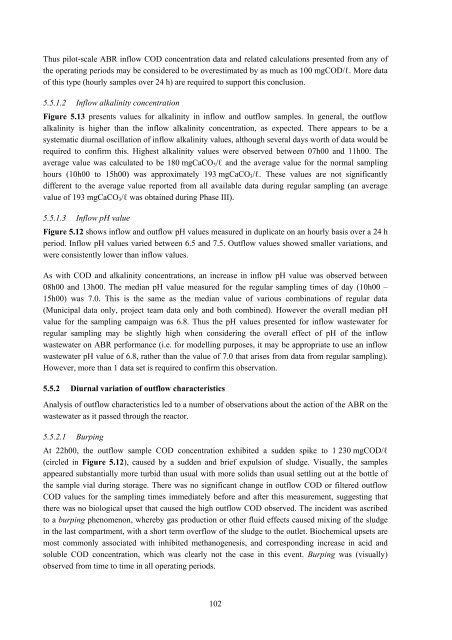analysis of a pilot-scale anaerobic baffled reactor treating domestic ...
analysis of a pilot-scale anaerobic baffled reactor treating domestic ...
analysis of a pilot-scale anaerobic baffled reactor treating domestic ...
Create successful ePaper yourself
Turn your PDF publications into a flip-book with our unique Google optimized e-Paper software.
Thus <strong>pilot</strong>-<strong>scale</strong> ABR inflow COD concentration data and related calculations presented from any <strong>of</strong><br />
the operating periods may be considered to be overestimated by as much as 100 mgCOD/ℓ. More data<br />
<strong>of</strong> this type (hourly samples over 24 h) are required to support this conclusion.<br />
5.5.1.2 Inflow alkalinity concentration<br />
Figure 5.13 presents values for alkalinity in inflow and outflow samples. In general, the outflow<br />
alkalinity is higher than the inflow alkalinity concentration, as expected. There appears to be a<br />
systematic diurnal oscillation <strong>of</strong> inflow alkalinity values, although several days worth <strong>of</strong> data would be<br />
required to confirm this. Highest alkalinity values were observed between 07h00 and 11h00. The<br />
average value was calculated to be 180 mgCaCO3/ℓ and the average value for the normal sampling<br />
hours (10h00 to 15h00) was approximately 193 mgCaCO3/ℓ. These values are not significantly<br />
different to the average value reported from all available data during regular sampling (an average<br />
value <strong>of</strong> 193 mgCaCO3/ℓ was obtained during Phase III).<br />
5.5.1.3 Inflow pH value<br />
Figure 5.12 shows inflow and outflow pH values measured in duplicate on an hourly basis over a 24 h<br />
period. Inflow pH values varied between 6.5 and 7.5. Outflow values showed smaller variations, and<br />
were consistently lower than inflow values.<br />
As with COD and alkalinity concentrations, an increase in inflow pH value was observed between<br />
08h00 and 13h00. The median pH value measured for the regular sampling times <strong>of</strong> day (10h00 –<br />
15h00) was 7.0. This is the same as the median value <strong>of</strong> various combinations <strong>of</strong> regular data<br />
(Municipal data only, project team data only and both combined). However the overall median pH<br />
value for the sampling campaign was 6.8. Thus the pH values presented for inflow wastewater for<br />
regular sampling may be slightly high when considering the overall effect <strong>of</strong> pH <strong>of</strong> the inflow<br />
wastewater on ABR performance (i.e. for modelling purposes, it may be appropriate to use an inflow<br />
wastewater pH value <strong>of</strong> 6.8, rather than the value <strong>of</strong> 7.0 that arises from data from regular sampling).<br />
However, more than 1 data set is required to confirm this observation.<br />
5.5.2 Diurnal variation <strong>of</strong> outflow characteristics<br />
Analysis <strong>of</strong> outflow characteristics led to a number <strong>of</strong> observations about the action <strong>of</strong> the ABR on the<br />
wastewater as it passed through the <strong>reactor</strong>.<br />
5.5.2.1 Burping<br />
At 22h00, the outflow sample COD concentration exhibited a sudden spike to 1 230 mgCOD/ℓ<br />
(circled in Figure 5.12), caused by a sudden and brief expulsion <strong>of</strong> sludge. Visually, the samples<br />
appeared substantially more turbid than usual with more solids than usual settling out at the bottle <strong>of</strong><br />
the sample vial during storage. There was no significant change in outflow COD or filtered outflow<br />
COD values for the sampling times immediately before and after this measurement, suggesting that<br />
there was no biological upset that caused the high outflow COD observed. The incident was ascribed<br />
to a burping phenomenon, whereby gas production or other fluid effects caused mixing <strong>of</strong> the sludge<br />
in the last compartment, with a short term overflow <strong>of</strong> the sludge to the outlet. Biochemical upsets are<br />
most commonly associated with inhibited methanogenesis, and corresponding increase in acid and<br />
soluble COD concentration, which was clearly not the case in this event. Burping was (visually)<br />
observed from time to time in all operating periods.<br />
102
















